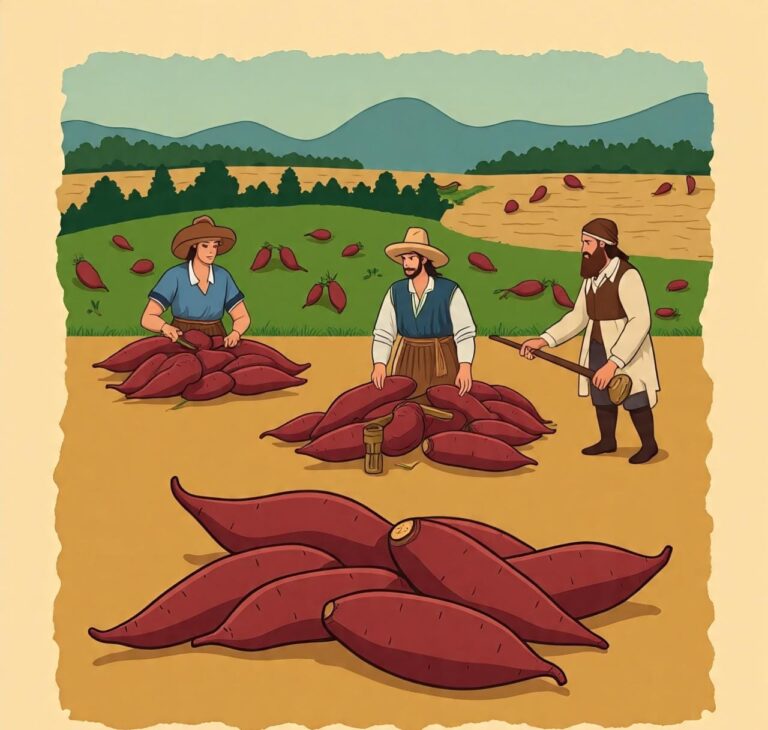When we think about sweet potatoes, most of us imagine warm, comforting dishes — sweet potato pie, baked sweet potatoes, or roasted wedges drizzled with honey. But beyond their delicious flavor, sweet potatoes carry a fascinating story. A common question often asked by history and agriculture enthusiasts is: how far did sweet potatoes travel to Georgia?
The journey of this root vegetable to the southern state is more than just about miles; it’s about centuries of trade, cultural exchange, agricultural adaptation, and migration. Understanding how sweet potatoes made their way to Georgia offers a deeper appreciation for the crop and its place in Southern cuisine.
The Origins of Sweet Potatoes
Sweet potatoes (Ipomoea batatas) are not native to Georgia, or even North America. They are believed to have originated in Central or South America, with archaeological evidence pointing to regions of modern-day Peru and Ecuador dating back over 5,000 years. Early indigenous communities cultivated them as a vital food source because they were nutritious, easy to grow, and adaptable to different climates.
From their native lands, sweet potatoes spread through:
- Maritime trade routes
- Indigenous migrations
- Colonial expeditions
This early movement set the stage for their eventual arrival in North America.
The Global Spread of Sweet Potatoes
The spread of sweet potatoes from South America was a global phenomenon. Historical records suggest:
- Polynesian sailors may have carried sweet potatoes across the Pacific centuries before European contact.
- Spanish explorers transported sweet potatoes to Europe in the late 15th and early 16th centuries.
- From Europe, they spread to Africa and Asia, adapting to diverse climates.
By the time sweet potatoes reached North America, they had already traveled thousands of miles — but how far did they travel specifically to reach Georgia? The answer requires looking at the colonial history of the southeastern United States.
Sweet Potatoes Arrive in North America
Historians believe sweet potatoes arrived in the southeastern region through Spanish colonists in the 1500s, particularly in Florida. From there, they spread northward due to their hardiness and suitability for warm climates.
The introduction timeline:
- Early 1500s – Spanish explorers bring sweet potatoes to Florida.
- Late 1500s–1600s – Indigenous peoples and settlers cultivate sweet potatoes along the southeastern coast.
- 1700s – Sweet potatoes become a staple crop in the Carolinas and Georgia.
How Far Did Sweet Potatoes Travel to Georgia?
If we measure from their believed point of origin in Peru, sweet potatoes traveled roughly:
- ~3,000 miles by land and sea routes to reach Florida.
- Then an additional ~350 miles north to Georgia.
Total journey: approximately 3,350 miles, not including detours through Europe, Africa, or the Caribbean, depending on their exact migration route.
However, for many sweet potatoes grown in Georgia today, the path might have been:
- Peru → Caribbean islands → Florida → Georgia
or - Peru → Spain → Africa → Caribbean → Southeastern U.S.
Either way, the distance traveled is impressive, making sweet potatoes a true globe-trotting crop.
Why Sweet Potatoes Thrive in Georgia
Georgia’s warm climate, long growing season, and sandy loam soils make it ideal for sweet potato cultivation. Farmers benefit from:
- Mild winters and hot summers.
- Adequate rainfall.
- Well-drained soils that prevent root rot.
These conditions mirror aspects of the sweet potato’s native environment, which explains why the crop adapted so well in Georgia.
Sweet Potatoes in Georgia’s Agricultural History
By the 18th and 19th centuries, sweet potatoes were firmly established as a Southern staple. They were valued for:
- Nutritional content – Rich in vitamin A, vitamin C, potassium, and fiber.
- Storage capabilities – Sweet potatoes store well for months, making them a reliable food source.
- Versatility – Suitable for savory and sweet dishes.
In Georgia, sweet potatoes became part of traditional Southern cuisine, influencing recipes passed down for generations.
Cultural Impact in Georgia
Sweet potatoes in Georgia are not just about farming — they’re tied to culture, tradition, and identity. They appear in:
- Thanksgiving dinners as pies or casseroles.
- Family gatherings in roasted or mashed form.
- Farmers’ markets and festivals celebrating the harvest.
Sweet potatoes also hold economic importance, with Georgia ranking among the notable sweet potato-producing states in the U.S.
Modern Production and Export
Today, sweet potato farming in Georgia benefits from:
- Improved farming techniques
- Pest-resistant varieties
- Sustainable growing practices
The state not only produces enough for local consumption but also contributes to exports, continuing the vegetable’s long history of travel.
Sweet Potato Varieties in Georgia
Georgia farmers grow several varieties, each suited to different culinary uses:
- Beauregard – Popular for high yield and sweet flavor.
- Covington – Known for consistent shape and vibrant color.
- Jewel – Common in Southern cooking.
From Ancient Trade Routes to Your Plate
The journey of sweet potatoes to Georgia reflects the interconnectedness of global agriculture. What started in the Andes thousands of years ago now thrives in Georgia soil, bridging cultures, continents, and centuries.
Fun Facts About Sweet Potatoes in Georgia
- Georgia celebrates sweet potato harvests in local fairs and community events.
- Sweet potato fries have become a popular healthier alternative to regular fries in Georgia restaurants.
- During the Civil War, sweet potatoes were a vital survival food for many Southern families.
Health Benefits of Sweet Potatoes
Sweet potatoes are more than tasty — they are a nutritional powerhouse:
- Support eye health due to beta-carotene.
- Help regulate blood sugar.
- Promote gut health with dietary fiber.
- Boost immune function.
These benefits explain why they remain a dietary staple in Georgia and beyond.
Sustainable Farming Practices
Georgia farmers are increasingly adopting eco-friendly practices:
- Crop rotation to maintain soil health.
- Drip irrigation to conserve water.
- Organic pest control to reduce chemical use.
Such measures ensure that sweet potato production remains viable for future generations.
Conclusion
So, how far did sweet potatoes travel to Georgia? The answer lies in a remarkable journey of over 3,000 miles, spanning continents, oceans, and centuries. From the ancient fields of Peru to the warm soils of Georgia, sweet potatoes have carried with them a legacy of resilience, adaptability, and cultural significance.
Today, when you enjoy a slice of sweet potato pie in Georgia, you’re tasting not just a locally grown vegetable but a piece of global history.

Christopher brings fresh perspectives through his writing, covering real-world insights and thought-provoking ideas. He regularly contributes to urbanmatter.com.in, engaging readers with quality guest content.

